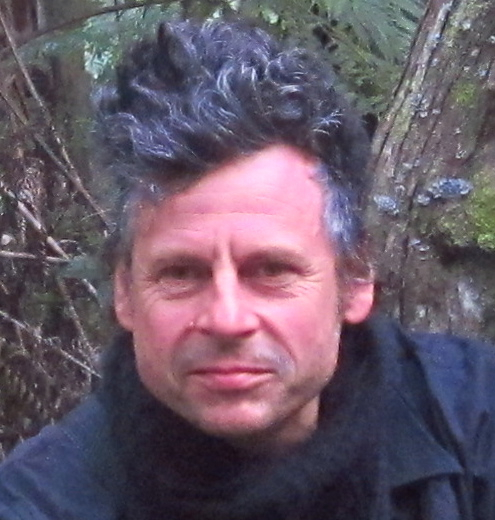Trash Aesthetics and the Sublime: Strategies for Visualizing the Unrepresentable within a Landscape of Refuse
by Emit Snake-Beings
published June 2015
Living in a technology-dependent society, it seems inevitable that our vision of the world is mediated and extended through our interactions with technology. We often realize the extent of technological mediation when our machines cease to function correctly. When a machine fails, we leave the predictably functioning world and enter into another realm. Think of the primitive magic of lighting candles during a power cut, where there is the potential of experiencing something sublime—something beyond the order and structure that technology imposes on us. On the other hand, when technology breaks it is also an opportunity to experience a myriad of emotions such as frustration, rage, loss, or boredom. In the face of technological failure, our ingrained response is to obtain a replacement, an upgrade, that promises greater freedom and a new way of visualizing the world. The old piece of technology turns to trash and falls silently and invisibly from our consciousness, as new technological vistas take command of our attention. The failure of machines can also be an intentional consequence of industry, such as the kind of in-built redundancy that drives the production and sale of new products, as discussed in Vance Packard’s book The Waste Makers or Slavoj Žižek’s commentary in Astra Taylor’s 2008 documentary Examined Life. While, in this sense, trash is intentional, there is also something about trash which has moved beyond function and human purpose: this is the link between trash and the realm of the sublime that I wish to explore in this essay.
Thus, the problem: how do we experience and represent what appears to be a sublime realm outside of technological mediation and devoid of human intention? How do we visualize the sublime world of trash and the failure of machines while retaining our codependency with technology as a means of visualization? Is there a way to engage with the paradox of trash, to represent the unrepresentable without changing it into something else? For it seems we can only visualize trash once it has been transformed into something that is more useful in the generation of meaning.
Language is often seen as a machine of representation, which, like technology, has its constant upgrades, failures, and redundant forms. When words fail to describe, we have what Immanuel Kant calls the feeling of the sublime (Observations on the Feeling of the Beautiful and Sublime 1764): an anomaly, or rupture in the power of language to encapsulate the world, an experience that cannot be placed within an overriding system of representation or visualization. Kant links the feeling of the sublime with the power of the natural landscape to evoke feelings that language fails to represent, and, as such, the sublime is a failure of language to represent something outside of the systems of human intention. For Kant, the sublime landscape is un-categorizable, falling between known emotions, such as pleasure and pain, beauty and ugliness, and defying a logical understanding of the world. In this essay, the sublime is linked to a trash aesthetic and is evoked through representations of a landscape made from refuse and garbage.
The link between the sublime and trash is suggested in John Scanlan’s book On Garbage when he writes: “[g]arbage does not strictly refer to an object, but is a jumble of inexactness [...] it seems to lack conventional referents […] garbage is the remainder of the symbolic order proper” (15-16). For Scanlan it appears that trash is a sublime object that exists outside of language, lacking in the “conventional referents” of the “symbolic order” we call language. While there is a strong argument that the production of trash is a necessary part of industrial and economic progress, such as the intentional redundancy and short life resulting from constant upgrades of technological products, there is also the feeling of a deep transformation that happens to technology when it becomes trash. Scanlan’s comments suggest that the transformation of technology to trash signifies a departure from human-intentional systems: trash is the chaotic residue of human systems that remains after order has been removed. In this sense, trash is the forgotten error of a broken machine excluded from the new languages of technology: a part of the visualizing system that has been removed from our sight. When trash is emancipated from contrived function and linguistic specificity, it inherits qualities of the sublime—a lack of form, a post-consumer mystique, a loss of language. Trash begins to exist outside of our command; it acquires a limitlessness that transcends its original design.
For me, a trash aesthetic is something that engages with the failure of machines and seeks out the sublime beauty of accidental errors, the unintentional, and the willfully excluded. A trash aesthetic can also be a way of reclaiming the unrepresented objects that have been discarded, turning them into statements about the inbuilt redundancy of technology and, on a larger scale, the unsustainable path of our current global trajectories.
If technology enables us to visualize the world, then the materials of trashed technology are the things we want to un-visualize or make disappear. One strategy of trash aesthetics could be to engage in the breaking down of the dichotomy between the visualizing ability of technology and the actual material objects of trash. Since (in most scenarios) garbage is the invisible material excluded from our technological systems—the errors and accidents that we do not want to see—the trash aesthetic is an engagement with something outside of the systems that humans use to define their world. Therefore, a trash aesthetic works with nonhuman systems that may be used to explore our world; such an aesthetic does so by breaking down the dichotomy between human and material and displacing the human as the central figure of intention or agency within visualized landscapes. As the following examples (from the author’s private collection) illustrate, an individual human artist is not necessarily central in the construction of works that engage in a trash aesthetic.
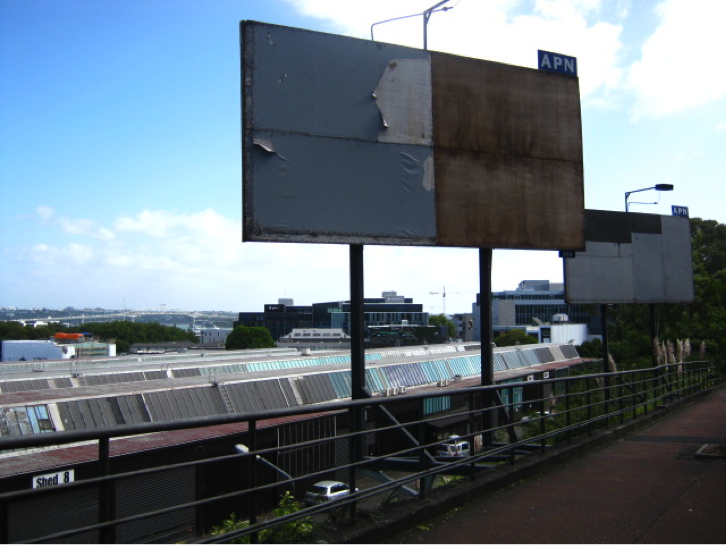
Shortly after the global economic crisis of 2008, a series of vacant billboards appeared in my local town, some of which are still here. With the resulting fall in advertising budgets, only the blank framework remains in place of the glossy images of consumerism. I have begun to view the redundant landscapes of post-crisis billboards as examples of trash aesthetics. As objects made without conscious human intention, I consider these billboards to be statements of emptiness, reflections and critiques of the current system of consumer-driven economics, and potent expressions of the unsustainable practices of the global economy. It is perhaps the actual objects themselves, rather than the mediated versions presented here, that hold the potential for a sublime experience. This presents an immediate problem of representation since it is the enframing of these objects, as photographic works, that creates the focus necessary for their presence as sublime objects—a simultaneous containment of an object within the language structure of mediating technology that, through an act of cultivated representation, dissipates the sublime experience. This dissipation of sublime qualities indicates the undefinable nature of the sublime. Once the sublime object has been brought into a structure of representation, it ceases to be sublime. Now cast through the human lens, the meaning of the mediated object becomes a servant to aesthetics, and, by the sublime's definition, can no longer transcend the system in which it is placed.
By infusing the empty billboards with meaning, as I am here, by placing the actual objects within a system of representation, media, language, or otherwise, the sublime qualities are dissipated. Such dissipation is suggested by John Scanlan, when he writes: “[t]here is no determinate and singularly applicable concept of ‘garbage’ […] the act of conceptualizing garbage actually transforms it into something else” (Scanlan 14-15). Following Scanlan’s view, the transformation of trash into “something else” is an unavoidable and integrated part of the enframing of trash. By imposing the intention of meaning over the actual material of trash, there is an unavoidable gulf that is generated between the actual object and its representation. Therefore, in the examination of the empty billboards, there is a constant skirting of the more nuanced issues involved in the relationship between the sublime and its representation. This is also apparent in the link between trash and the technologies we use to represent trash. In this case, I would like to refer the reader to similar billboards within their own towns, the actual physical spaces rather than the images presented on the page or screen, seeking out these spaces of emptiness within the consumer landscape and applying the following viewpoints to these objects of trash. In this sense, the media platform of the empty billboard is the actual object itself and the scale of media corresponds to the scale of economic crisis responsible for the appearance of the billboard. By viewing the empty billboards in situ, the subjective qualities of the sublime emerge from an individual engagement with the ambiguous material objects in our landscapes.
Looking at the empty billboard as a street-based, sculptural object, I am reminded of the Adbusters’s activist campaign known as Buy Nothing Day, which occurs annually on November 29th, and is allocated by Adbusters as a global day of conscious (non)consumerism. The in-situ blank billboard can be read as an emergence of visible trash within the language of consumerism. While not directly connected to the human intention of creating a message, it is possible to read these signs as politicized artworks created by complex economic and industrial processes. In reading these discarded spaces as artworks, emanating from something other than human intention and design, we see a trait of trash aesthetics: a playfulness with the discarded material of the environment allows garbage and other excluded materials to be reconfigured into different functions beyond original human intention. The re-functioning of garbage, in the case of the empty billboards and the intended function of advertising, has resulted in uncontrolled spaces of discarded consumerism: these signs can be reappropriated just as the objects of garbage can be recycled.

As an object of trash aesthetics, this is art not created by the individual, but by a complex interconnection of nonhuman events, processes, and failures of the economic machine. The empty billboards represent an error of the system overridden by what Jane Bennett calls the affect of “vibrant matter” upon a global network. Instead of an absence of meaning, the materials of the billboards emerge as a conspicuous absence of consumerism: a highly visible advertisement to “buy nothing” and to question the purpose of the economic system, emerging from a pause in the flowing landscape of consumerism. The “vibrant matter” of the billboard and its associated failure of the economic system, therefore, appear to be the main agents in the construction of the artwork. This creative process displaces human intention as the driving force of agency, allowing all kinds of nonhuman actants to emerge as powerful forces behind the creation of the sublime landscape of the empty billboards. The sublime, in this sense, can be felt in the work of nonhuman actants: materials acting in parallel to human intention. This argument of agency acting in parallel to human intention is supported by Jane Bennett when she writes that an “actant never really acts alone […] A lot happens to the concept of agency once nonhuman things are figured less as social constructions and more as actors” (21). In looking at the empty billboards as works of art, a trash aesthetic emerges—one composed of an ethos that acknowledges the material forces of discarded trash as a visible actant within the creating process. To some extent, the inclusion of trash as an actant displaces human-centered systems of representation, embracing the sublime language of materials.
Representations of waste are something intangible and difficult to grasp. It is as if garbage is a material that is outside of the structure of our usual interactions with technology since it is defined by what it is not, rather than what it is. When garbage is expelled from our collections of useful objects, it becomes linked to the sublime as “a negative representation, or even a non-presentation” (Lyotard 204). If this is the case, then garbage only becomes an object of representation when it is reappropriated into a human-oriented language, i.e. when it becomes useful as an object for human consumption, as an artwork, or as another functional object. Until garbage is integrated within a system of human intention—or human systems are integrated with the materials of discard—then trash remains part of the intangible sublime, as “a reality somehow beyond and different from intelligible structure” (Gutting 318). If “intelligible structure” is read as a structure borne from human intention, then a strategy of trash aesthetics could be to displace the human as a central agent of meaning and to give voice to the material.
While the manufacturers of commercial materials, products, and structures willfully manage the lifespan and death of their products, the ownership of singular and cumulative waste’s afterlife is undesignated. After obsolescence, these objects move beyond intent, free to fall outside of the productive, purposeful realm and into the spaciousness of the sublime. The sublime has been envisioned as “something that exceeds the ordinary” (Jos De Mul n.p.), and thus, the liberation of these objects from function bestows on them a divinity that can be enlisted into the counter-cultural act of aestheticizing trash.

The above image from David Lynch’s 1977 film Eraserhead incorporates abandoned factory spaces as the backdrop to a sublime and incomprehensible filmic world in which objects are imbued with mysterious, almost sentient, qualities. The voice of materials can also be “heard” in the 2014 book David Lynch: The Factory Photographs, a continuation of his life-long obsession with empty and decaying factories. In this book, Lynch gives voice to a landscape where “every work ‘talks’ to you, and if you listen to it, it will take you places you never dreamed of” (qtd. in Giloy-Hirtz). The factory photographs are a documentation of abandoned derelict industrial spaces throughout Europe, which allow the multiple processes of material decay to be expressed through the affected materials of the landscapes.
While the media representation of The Factory Photographs means that the actual objects of trash, i.e. the empty factories, become enframed and visualized from within the mediating language of photographic technology, it is the scale of the actual objects themselves that is an important factor. Again, this creates a problem of representation versus the actual object. While Lynch has brought the empty factory into focus as an object of sublime beauty, it is the scale and experience of the actual object that is, in part, what I examine here, not its media representation. The advice is for readers to seek out similar spaces of empty industry within their own environments and to experience the scale of the material object, looking beyond the visualizing tool of the media into the unmediated space of the sublime.
As a strategy of representing the industrial waste left behind when the human is removed from the landscape of the factory, Lynch’s images reveal a trash aesthetic that values the expression of the material over the human. For example, the untitled black and white image on page 57 depicts the deserted interior of a factory workshop and engages in the material residues of industrial processes that have marked the walls, floors, and ceilings—just as a painter may leave inadvertent marks on an easel. The remnants left behind after heavy industry has departed resemble the scene of the leftovers of a debauched party: materials have been consumed to depletion in a chaotic fashion, the humans and their useful products have departed, leaving behind the debris and remains of the processes of consumption and production. The human-less spaces of the factory, with the chaotic stains and marks caused through the incidental processes of industry, resemble Gutting’s idea of the sublime as a reality beyond “intelligible structure.”
In dealing with the incidental material processes of the factory, Lynch is engaging with structures that have been abandoned by humans and left to other organizing forces: “his aesthetic interest is in things which have been neglected. Broken windowpanes, cut power lines, clogged pipes, crumbling plaster, [and] stains” (Giloy-Hirtz 25). In this way, Lynch reveals the discarded residues of industry as enabling an engagement with a landscape made from sublime unintelligible structures. The strategy of representing the mess behind human structure is part of a trash aesthetic that displaces human intention, which may appear strange since, obviously, the images are presented in a book—an intentional object of representation. However, once again, media is being used here to provide accessible examples of the actual objects themselves, suggesting that the sublime is caught up with the paradox of representation: all forms of enframing, including the human eye, can be seen as ways in which the uncategorizable is mediated and encapsulated within a human-based language structure. In viewing Lynch’s images, I experience the ambiguous and ambivalent feeling that the empty factories exist independently of human en-framing. By this I mean that it is not completely necessary for the factories to be designated as works of art for the sublime experience of the factory landscape to emerge, but there is nonetheless the necessity to enter the landscape with an intention to transform the neglected landscape into “something else,” as Scanlan pointed out earlier in regards to garbage. This ambiguity between object and intention has been a topic of several avant-garde movements and artists of the twentieth century; Marcel Duchamp’s Fountain, a work of art comprised from a reappropriated “ready-made” porcelain urinal, stands as one of the most enduring examples. From the viewpoint of a trash aesthetic, the ambiguity between object and intention differs from Duchamp’s appropriation of an everyday object and subsequent critique of the art world since Lynch’s aim seems to be to deemphasize the power of human intention to transform objects into art.
As Lynch acknowledges, his trash aesthetic is concerned with the expression of something outside of intentional structure: “I hate slick and pretty things. I prefer mistakes and accidents” (qtd. in Giloy-Hirtz 31). Lynch’s “mistakes and accidents” occur in the material qualities of the empty factories, where marks and scrapes on the walls made without human intention become appropriated as objects of sublime beauty. In dealing with structure, Lynch’s factory photographs display a trash aesthetic that incorporates the human and the material as equally valuable voices, so that “[w]hen you see an aging building or a rusted bridge, you are seeing nature and man working together” (Lynch 119).
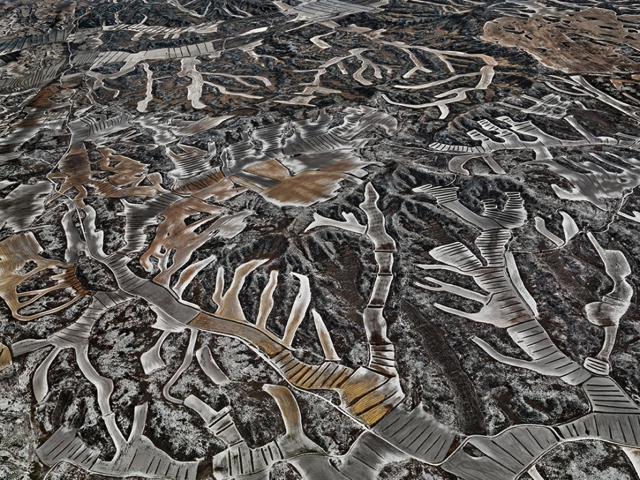
Another artist working with the trash aesthetic is the Canadian photographer Edward Burtynsky. The 2007 documentary Manufactured Landscapes depicts Edward Burtynsky’s photographic landscapes as a process of various large-scale industrial operations, as seen above. The documentary begins with the making of a series of photographs based on the extraction of raw materials, where large-scale earthworks are reminiscent of the 1970’s sculpture Spiral Jetty by Robert Smithson. The difference here is that of the relationship between object and intention, whereby the material of Spiral Jetty has been placed with the intention of creating an artwork, and the material of Burtynsky’s landscapes has been created through industrial intention. In Burtynsky’s photographs, intention is more ambiguous than that of transforming the materials of landscape into works of art. Certainly the photographs, in themselves, do function as works of art. The images, however, can also function as politicized statements of the effects of human intention upon the natural landscape. The images are a means of creating a platform for the visualization of industry, trash, and pollution.
Working with the vast scale of industry’s ability to reshape the landscape, Burtynsky embodies a trash aesthetic concerned with the sublime qualities of a manufactured, rather than natural, landscape. Again, we encounter the paradox of representation and the effects that media scale can have on the viewer. Would viewing Burtynsky’s film evoke a different response if seen in the context of a large-screen theater compared to the micro-screen of a mobile device?
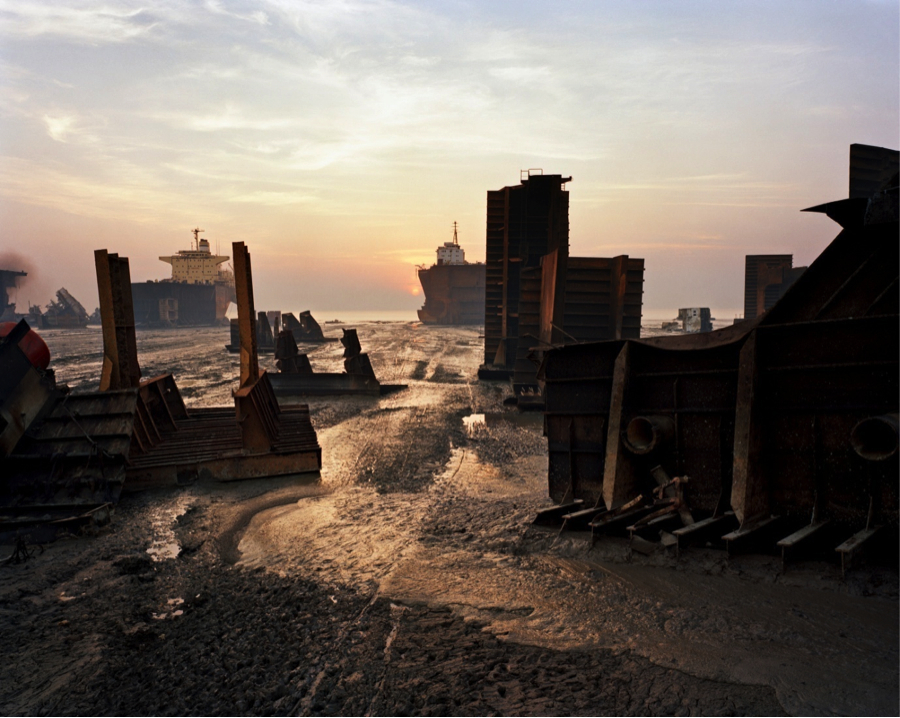
My argument is that the representation of Burtynsky’s industrial landscape also contain its own integral representation of scale. Thus, whichever media is used to visualize these landscapes, the fact remains that it is apparent that the actual waste objects are examples of the intensely vast effect that industrialization has on a landscape. As seen in the image above, the scale of the landscape would be apparent on a variety of media platforms since the extent and scale of industrialization is incorporated into the photographic space as an intentional aspect of Burtynsky’s image; this suggests that the media representation and mode of visualizing the manufactured landscape are indexically locked to the scale of the actual material object, and that the representation is merely one accessible version.
An interesting feature of Burtynsky’s work is the apparent intention of avoiding directly criticizing industry as the source of environmental damage. Burtynsky’s version of the sublime is more aligned to Lyotard’s idea of the sublime, as a realm outside of the limitations of the rational mind in which: “art does not imitate nature, it creates a world apart […] in which the monstrous and the formless have their rights because they can be sublime” (Lyotard 202). In Burtynsky’s photographed landscapes, the “monstrous and formless” are seen in the inbuilt scale of industrial processes that have been applied to the land: “monstrous” in their size and scale and “formless” in their seemingly arbitrary purpose which drives and directs our industrial world, as seen in an image from Burtynsky’s film below:
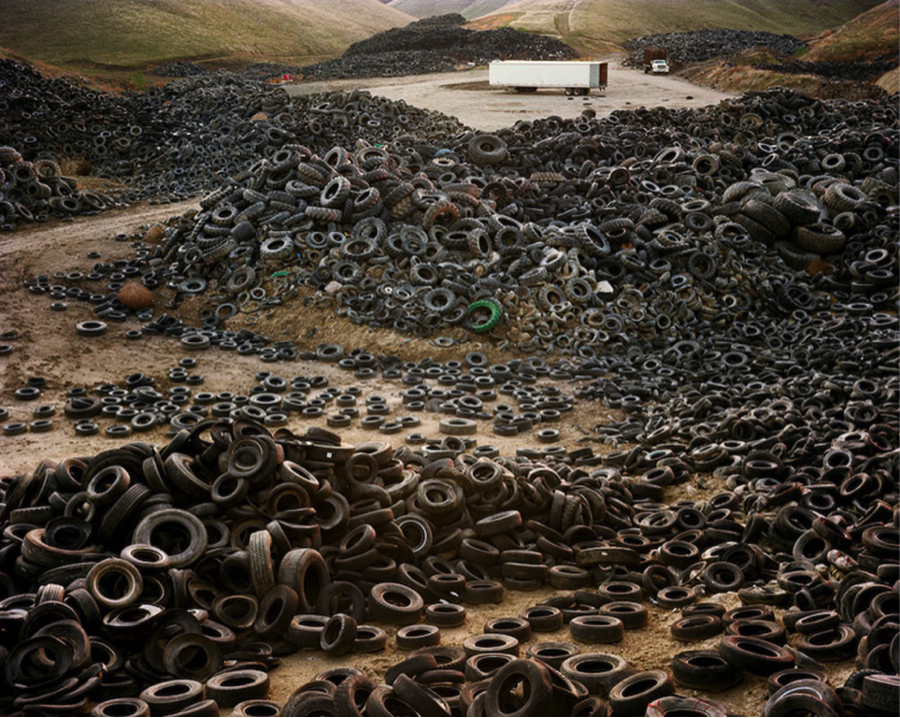
The surreal landscape of discarded vehicle tires acts as a representation of functionality and process, rather than as a self-contained landscape. The endless rubber mountains of the image suggest an on-going process of industrial discard: a landscape of endless trash driven by consumption and industry, forces that are conspicuously absent from the visual imagery of rural-based waste.
As an engagement with the scale of the trash landscape, the photographs of Chris Jordan also evoke some of the same overwhelming aspects of the sublime as Burtynsky’s photographs, as seen below.
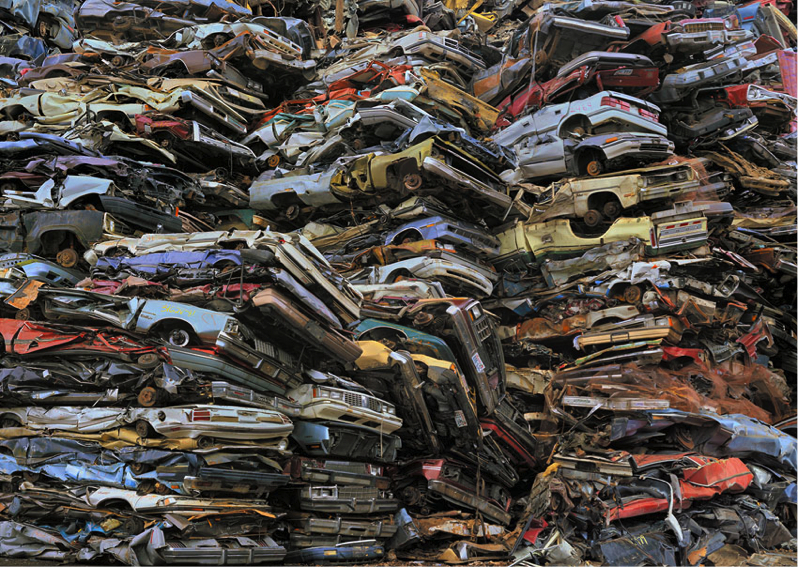
In Jordan’s photograph of crushed cars, the “monstrous” scale of the industrial landscape is apparent in the sheer number of compacted objects. The familiar scale of the car provides an integral reference to the scale of the landscape, and, as such, the representation acts as a carrier of the sublime landscape of the actual material objects. This is not to say that the image is unmediated, but that scale is present in the indexical link to the material object. The immense scale of the waste landscape evokes the sublime, linking trash with something outside of the usual vocabulary of technology. By becoming immense in scale, waste begins to exist outside of our command and control, and by doing so, it acquires a limitlessness that transcends its original intended purpose.
My aim in providing these above examples has been to demonstrate tactics available for engaging in the trash aesthetic in a way that allows the sublime to enter into the process. As in the historical observation of the sublime, the act of witnessing the ineffable dominance of the sublime in nature can be enacted in contemporary territories through unmediated instances of the trash aesthetic. I have suggested throughout this essay that the scale of the waste landscape, coupled with the indexical link to the actual material of waste, means that technology ceases to be an “invisible” visualizing and enframing device through which we view the world. Through its visible appearance, trash brings to light the inefficiency of our technologies, helping us to question the scope and supposed clarity of its vision. By engaging with materials, nonhuman processes, and structures, the trash aesthetic can be used to draw attention away from the human and toward other systems of organizing the world. By using trash to visualize the world, rather than technology, we allow these usually excluded vibrant materials the agency to organize the world for us. The sublime is only “formless” (Lyotard 202) and “different from intelligible structure” (Gutting 318) because we, as humans, place ourselves as the central figures in manufacturing structures. Once we begin to accept that nonhuman structures can be of equal importance, it becomes less possible to justify the ecological devastation wrought by producing an endless stream of soon-to-be-redundant consumer products—products that are merely one way to visualize and structure the environment.
Works Cited
Manufactured Landscapes. Dir. Jennifer Baichwal, 2006. Film.
Bennett, Jane. Vibrant Matter. Durham: Duke UP, 2010. Print.
"Buy Nothing Day." Adbusters. 2014. Web. 13 June 2014.
De Mul, Jos. "The Technological Sublime." nextnature.net. Next Nature Network. 17 July 2011. Web. 13 Jan. 2015. <http://www.nextnature.net/2011/07/the-technologica...>.
Examined Life. Dir. Astra Taylor, 2008. Film.
Jordan, Chris. Intolerable Beauty: Portraits of American Mass Consumption (2003 - 2005). 2005. Web. 13 Jan. 2015.
Giloy-Hirtz, Petra. David Lynch: The Factory Photographs. New York: Prestel Verlag, 2014. Print.
Gutting, Gary. French Philosophy in the Twentieth Century. Cambridge: Cambridge UP, 2001. Print.
Kant, Immanuel. Observations on the Feeling of the Beautiful and Sublime. Trans. John T. Goldthwait. Berkeley: U of California P, 2003. Print.
Lynch, David. Catching the big fish: Meditation, consciousness and creativity. NY: Tarcher, 2006. Print.
Lyotard, Jean-François. "The Sublime and the Avant-Garde." Trans. Geoffrey Bennington, Lisa Liebmann, and Marian Hobson. The Lyotard Reader. Ed. Andrew Benjamin. Oxford: Blackwell, 1989. 196-211. Print.
Packard, Vance. The Waste Makers. London: Longmans. 1961. Print.
Scanlan, John. On Garbage. London: Reaktion, 2005. Print.
Figures
Figure 1: Empty Billboard #17, Hamilton, New Zealand. Author's photograph. 2008. JPEG.
Figure 2: Empty Billboard #23, Hamilton, New Zealand. Author's photograph. 2008. JPEG.
Figure 3: Film still from Eraserhead. Dir. David Lynch. Perfs. Jack Nance, Charlotte
Stewart, Allen Joseph. 1977. DVD. Criterion Collection, 2014. JPEG.
Figure 4: Film still from Manufactured Landscapes. Dir. Jennifer Baichwal. Perf. Edward Burtynsky. 2007. DVD. Zeitgeist Films, 2007. JPEG.
Figure 5: Film still from Manufactured Landscapes. Dir. Jennifer Baichwal. Perf. Edward Burtynsky. 2007. DVD. Zeitgeist Films, 2007. JPEG.
Figure 6: Film still from Manufactured Landscapes. Dir. Jennifer Baichwal. Perf. Edward Burtynsky. 2007. DVD. Zeitgeist Films, 2007. JPEG.
Figure 7: Jordan, Chris. Crushed cars #2, Tacoma. 2004. Chris Jordan Photographic Arts. Web. 1 June 2011. JPEG.

